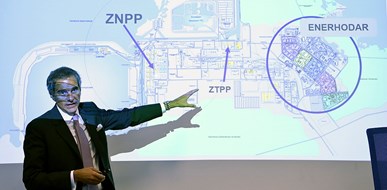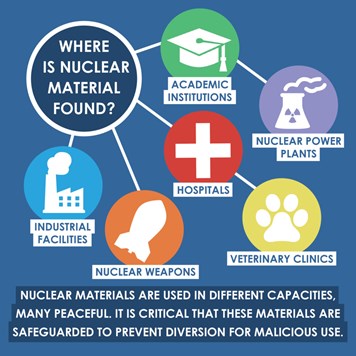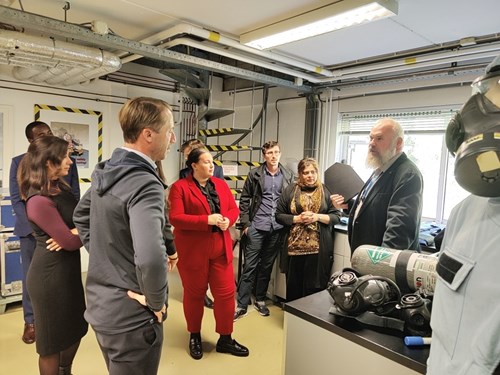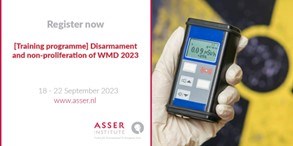'Dirty bombs' and nuclear power plants: How does international law protect us from nuclear disaster?
Published 30 August 2023By Thea Coventry

Rafael Mariano Grossi, IAEA Director General, briefs members of the international press. 12 September 2022. Photo by: Dean Calma / IAEA (c) Creative Commons Attribution 2.0 Generic license.
In March 2023, the Director General of the International Atomic Energy Agency (IAEA) visited Ukraine’s Zaporizhzhya Nuclear Power Plant (ZNPP) for the second time to assess nuclear safety and security. He brings with him a new group of IAEA experts to replace those already at the nuclear power plant to help reduce the risk of a nuclear accident. Visits like these are facilitated by international safeguards and verification regimes such as that of the International Atomic Energy Agency (IAEA).
The consequences of damage to a nuclear reactor are devastating. Lethal amounts of radiation are released immediately, and radioactive particles can spread unpredictably over large distances poisoning flora and fauna for hundreds of kilometres. Military activity in and near power plants, as is the case at the Zaporizhzhya Nuclear Power Plant, makes it more likely the power plant could be damaged with catastrophic consequences.
IAEA safeguard agreements
Nuclear power plants are afforded protection under international humanitarian law, but the IAEA also continuously fulfils a vital role in nuclear safety and security during conflict and crisis. The Statute of the IAEA and the comprehensive safeguard agreements place requirements on the health and safety measures for nuclear material. This provision provides important support in situations where nuclear facilities and materials may be at risk, such as during armed conflict. It allowed the IAEA to visit Ukraine’s Zaporizhzhya Nuclear Power Plant (ZNPP) and also enabled the Director General to discuss with the establishment of a Nuclear Safety and Security Protection Zone with Ukraine and Russian Federation.
Safeguard agreements are integrated into the framework of the NPT, which entered into force in 1970 and remains one of the most important agreements in nuclear non-proliferation and disarmament to this day. The IAEA comprehensive safeguard agreements are set up directly between the States and the International Atomic Energy Agency, but all non-nuclear-weapon States party to the NPT are required to conclude comprehensive safeguards agreements with the agency.
Monitoring and verification to prevent ‘dirty bombs’
Even outside of nuclear power plants, there are risks of radiation exposure. Nuclear materials be found in hospitals, academic institutions, power plants, and even veterinary clinics. In hospitals, positron emission tomography (PET) nuclear material is used to find detailed information on how organs are working and whether cells are damaged, for example.

Infographic by Center for Arms Control and Non-Proliferation
International agreements and safeguards ensure that access to these materials is restricted, protecting them from theft, sabotage, or other malicious acts such as the construction and use of a ‘dirty bomb.’ In a ‘dirty bomb’ conventional explosives such as dynamite are mixed with radioactive material.
Close monitoring and restrictions on radioactive materials help secure nuclear materials to be used for peaceful purposes. This ensures that they do not fall into the wrong hands. These materials remain dangerous even when not acquired with the intent to harm. When an unsecured radiotherapy source was stolen from an abandoned hospital site in Brazil in 1987 it led to four deaths and the contamination of hundreds. Once the news of the contamination was shared, a deluge of nearly 130,000 people poured into local hospitals concerned that they might have been exposed. This type of dramatic reaction shows the fear that nuclear materials can evoke. ‘Dirty bombs,’ make use of these concerns to cause more confusion and damage.
In addition to anxiety and uncertainty caused by possible exposure, nuclear material will disperse and contaminate a limited area around the detonation. This contamination can still render facilities unusable and disrupt lives and livelihoods.
‘Dirty bombs’ have never been used. In part, due to the effective regime in place that tracks and monitors incidents of theft, shares best practices for protecting the materials, and secures or removes materials from vulnerable locations. The International Atomic Energy Agency is central to this regime having tracked 3,686 confirmed incidents of theft or loss of material around the world between 1993 and 2019. In addition to careful restrictions and monitoring making it difficult to obtain nuclear material, there are only a few kinds that are radioactive enough to pose a significant threat. Furthermore, nuclear materials are straightforward to detect through Geiger Counters, gamma-ray detectors, and several specialised radiation detectors.
Success of monitoring and verification regimes
Safeguarding and verification are a key part of preventing the use of weapons of mass destruction. Provisions for verification and safeguarding processes are enshrined in the Treaty on the Non-Proliferation of Nuclear Weapons (NPT) as well as the Chemical Weapons Convention (CWC), two of the most important treaties in the disarmament and non-proliferation framework.
Chemical weapons are more difficult to detect than nuclear material and some potentially harmful chemicals are common ingredients that can be found in daily items. For example, thiodiglycol, an ingredient in pen ink, is also a precursor to mustard agents. Monitoring and technical support has played a key role in preventing chemicals from being weaponised as the Convention requires States Parties to submit information each year on the details of production, uses and transfers of chemicals which have a high potential for non-peaceful use.
The verification division is part of the technical secretariat of the Organisation for the Prohibition of Chemical Weapons (OPCW) in The Hague. As the key part in the verification regime, it has done over 1,907 site inspections since the treaty has entered into force in 1994.

Participants of disarmament and non-proliferation training programme visit OPCW storage facilities in 2022
The power of international law
Arms control agreements cannot be left to stagnate, they require maintenance and regular updates. As indicated in an earlier interview with Professor of International Arms Control Law Thilo Marauhn, after the Cold War, many decision-makers - naively - neglected several arms control agreements like the Treaty on Conventional Armed Forces in Europe. Adaptation efforts ran into a dead end, which ultimately led to the end of the treaty itself. The NPT Review Conferences of 2015 and 2020 also ended without a consensus on a way forward, therefore the skills to understand and adapt the mechanisms of these treaties is more important than ever.
The power of international law and treaties such as the NPT and the CWC lies in their ability to provide practical tools for dealing with the threat of weapons of mass destruction. International agreements are crucial to establish binding standards and effective monitoring mechanisms.
About Thea Coventry
Thea Coventry is a researcher in international law at the Asser Institute within the research strand ‘Regulation in the public interest: disruptive technologies in peace and security’. Thea’s research focuses on international arms control agreements and their compliance. Her research interests include international arms control law, maritime security, and transnational criminal law. and non-conventional weapons. Together with Prof. Thilo Marauhn she is the driving force behind the Arms Control Law Hub.
Interested in the disarmament and non-proliferation framework?
Develop your knowledge on the diplomatic, legal, and technical aspects of disarmament and non-proliferation of weapons of mass destruction at our in-person training programme organised together with the OPCW. Speakers, include, among others, the Director-General of the OPCW, senior officials from the International Atomic Energy Agency (IAEA), the International Committee of the Red Cross (ICRC), the UN Office for Disarmament Affairs (UNODA), as well as the Dutch Ministry of Foreign Affairs. Read more.
Arms Control Law Hub
Committed to educating the next generation of experts in arms control the Asser Institute established the International Arms Control Law Hub in The Hague in 2021. While encompassing conventional arms, the emphasis of the Arms Control Law Hub is on arms control law with respect to nuclear, chemical and biological WMD, and nuclear security. Read more.

